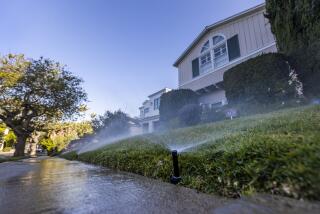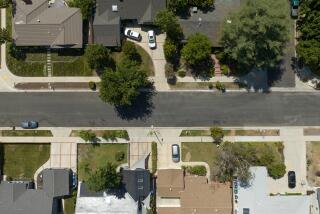New Water Conservation Rules Are Changing Area’s Landscape : Developers Are Forced to Look for Ways to Dress Up Exteriors With Drought-Resistant Plants That Won’t Turn Off Customers
- Share via
Los Angeles restaurant patrons grumble about having to ask specifically for water. Homeowners tinker with leaky faucets and wait for low-flow shower heads to show up in their mailboxes. Builders fret about limits on new sewer hookups.
But the city’s new water conservation legislation also has a less visible, less publicized provision. For the first time, developers seeking building permits for industrial, commercial and multifamily residential structures must persuade the City Planning Department that the landscaping conserves water.
A detailed point scheme rewards the installation of swimming pool covers to reduce evaporation, the planting of drought-resistant plants that can “survive and look well” on natural rainfall alone, and the use of reclaimed water and advanced irrigation systems. The scheme strongly encourages planting of lawns that make up less than a quarter of the overall planted area. And the bigger the project, the more points are needed for a building permit.
California’s drought has not dried up sales this year for the state’s multibillion-dollar landscaping and nursery industries. But as city planners impose more restrictions, landscape architects and contractors are forced to focus on marketing a drought-resistant product line their customers may not want.
Los Angeles did not limit landscaping during the harsh drought of the late 1970s, but circumstances have changed since then, said Emily J. Gabel, a principal city planner for the planning department. Dramatically more efficient irrigation systems have come on the market in the past decade, while landscape architects have become more aware of how to use drought-resistant plants, she said. “It surprised me that this hasn’t come along sooner. Los Angeles is an arid climate. . . . (The point system) is set up as a temporary ordinance, but I expect it will become permanent in the future.”
Consumes Much Water
California water agencies have published brochures and sponsored garden contests in an effort to promote water-conserving landscapes as more than rock gardens with a few cactuses. Yet interest among homeowners and developers remains slim. Most customers do not examine drought-resistant alternatives until they are suggested by a contractor, and even then many are reluctant, said Nelson L. Colvin, vice president and general manager of California Landscaping in Canoga Park. “There are some people (who) want the lawns, they think they look better. . . . They’re willing to pay the price for the water to get it.”
Federal government office buildings and the “corporate campuses” of large corporations seeking to retain valuable employees are the most likely to have plush lawns and huge water bills, he said. “Some of the big aerospace companies--they don’t care.”
Los Angeles officials say they have good reason to regulate the landscaping industry: Watering lawns and gardens accounts for close to half of residential water use in the city. And Los Angeles is not alone in seeking controls. Several Northern California counties are introducing more stringent restrictions. The East Bay Municipal Utility District in Alameda and Contra Costa counties is largely restricting the installation of new landscaping to drought-resistant plants with drip irrigation systems. The district’s staff recommended a complete ban on new landscaping, but the idea died because “we had a lot of protest from the green industry,” spokesman Gayle B. Montgomery said.
And east of Sacramento, the El Dorado Irrigation District ordered on March 23 that until more normal rainfall and snow pack return, all outdoor planting is banned on construction projects, and new homes will be “allotted water only for living and not for exterior planting,” spokeswoman Dorine M. Kelly said. More recently, El Dorado County has decided that developers of current construction projects can post bonds to pay for future installation of landscaping, instead of laying sod and planting trees as soon as buildings are ready.
Vast Differences
Bans such as El Dorado’s are understandably unpopular with landscapers. “They’re making a drastic mistake. . . . I think it’s ludicrous,” said Colvin, who is also chairman of the California Landscape Contractors Assn. Landscaping is needed to control erosion and provide pleasant areas for children to play outdoors, he said, adding that widespread use of drought-resistant materials in commercial and residential can produce water savings of 15% to 20%.
To stay green, a square foot of lawn in Southern California requires the equivalent of an 16-foot-tall column of irrigation water each year, said Joseph J. Millman, a Redondo Beach landscape architect. A square foot of azaleas and ferns needs six feet, while drought-resistant plants need four feet or less.
Newly available high-tech irrigation equipment can also produce dramatic gains in watering efficiency, Millman said. Soil moisture and rainfall meters for automatic sprinkler systems are now available at moderate cost, as are finely calibrated clocks that turn sprinklers off and on several times a day to soak the earth gradually instead of leaving puddles that evaporate, he said. A $50 rainfall meter--which temporarily turns sprinklers off after a good rain--can pay for itself through lower water bills in a single year at a large residence.
Los Angeles’ new point system is overly generous in rewarding the use of such equipment, Millman said, recalling that a recent small apartment project that included a small lawn and still received 2 1/2 times as many points as needed. “I don’t think these requirements are going to be stringent enough to make a difference.”
Millman and several other landscapers argued that water-conserving landscaping is not expensive. But Klaus Kumme, owner and president of Chatsworth-based Kumme Landscaping, said that using drought-resistant plants and other materials can easily double the initial cost of landscaping a house or apartment project.
Demand for water-conserving native California plants--such as flowering gooseberry, catalina cherry and a local variety of manzanita--has stagnated in part because of the extra cost, said Arthur (Bud) A. Arntzen, production manager at Boething Treeland Farms in Woodland Hills. “Most of them are not attractive compared to other plants, and there’s not a lot of growers, and they usually cost a few dollars more.”
The native plants typically cost 30% more than other plants of similar size because they are very susceptible to pests and disease, and because workers require extra training to water them without drowning the roots, he said.
Drought-resistant plants are the slowest sellers at Azusa-based Monrovia Nursery Co., which claims to be the world’s largest wholesale nursery for plants in containers. “What really isn’t in big demand and people need to wake up to is drought-resistant plants,” assistant production manager Dennis M. Connor said. “People think of a drought-resistant plant and the first thing they think is, ‘It’s ugly.’ ”
Plants that require little or no irrigation make up no more than a quarter of the 40 million plants Monrovia grows in Azusa each year, he said. Desert areas in California and farther inland account for most of the demand, he added. “It’s funny, most of those plants go out of state, to Arizona and such.”
Statewide nursery sales do not appear hard hit by the drought, said Jack A. Wick, executive director of the California Assn. of Nurserymen. “The spring started so early this year that business was extremely good.”
But if drought worries continue, he said, sales will suffer. “When that’s just everyday conversation, that does tend to dissuade people from planting gardens.”
Impact Is Mixed
Estimating the economic effect of drought on landscape architects and contractors is virtually impossible, as no one can agree on the size of California’s industry, much less the effect on sales from water conservation. Because definitions of landscaping vary and because California landscaping companies tend to be privately held and do not disclose their annual sales, estimates of the industry’s annual revenue vary enormously, from $2 billion to $5 billion or more. About 60% of the market is in Southern California, Colvin said.
The drought’s impact is mixed because while some projects may be scaled back, canceled or postponed, others are started to save water, said Joe Heath, executive officer of the California Board of Landscape Architects, a state licensing agency. “As the water shortage gets more critical, landscape architects are called in even to redo landscaping.”
Yet efforts to promote alternatives to sod may have a ways to go. The Los Angeles Department of Water and Power last month held its third annual contest for the most attractive, water-conserving garden. Several winners looked suspiciously like rock gardens with cactus.
P. Gus Dembegiotes, a water conservation associate for the department, said he was “not embarrassed” by the recent winners. “It just happened there were a lot of rock garden (applications) . . . We’re not just looking for cactus. We’re hoping we’ll get more.”
More to Read
Sign up for Essential California
The most important California stories and recommendations in your inbox every morning.
You may occasionally receive promotional content from the Los Angeles Times.










